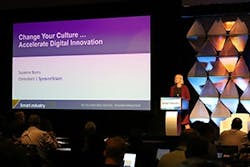Why digital transformation initiatives fail
In the past decade, manufacturers have become savvier about the need to use data—specifically, contextual analysis of real-time and historically trended data—to drive smarter decisions about maintenance, production, labor use, and business strategy. There's a greater appreciation, too, for the need to ensure that an organization has the talent in place to help make sense of, and make use of, Big Data and clearly convey the business value of a more-data-driven approach to all teams.
And so digital champions are brought on board and/or cultivated from within the organization. Organizations look to these individuals for fresh perspectives and a fresh approach. So why do so many digital initiatives fall flat, and why do these designated change agents wind up walking out the door?
Throughout the opening presentations and panel discussions on Day 1 of the 4th annual Smart Industry conference in Rosemont, IL, on Monday, the theme of aligning company culture with the organization's digital objectives and evolving business strategy was at the forefront.
When it comes to hiring or promoting individuals to help lead digital initiatives, "Do you have an organization that is going to accept those individuals?" asked Suzanne Burns, a consultant with SpencerStuart, in her opening presentation. A recent study found that 9 out of 10 digital transformations did not meet the business objectives they set out to achieve, Burns noted, and issues pertaining to the organization's culture often are at the root of these failures.
Traditional industrial companies that have been around for the better part of a century or longer tend to prioritize order and prescribed processes—the "that's just how things get done around here" approach—over learning and experimentation, which younger employees and talent hired from tech-centric companies tend to be most used to and thrive on. It can be really difficult to match the digital talent who would help companies meet their digital objectives with the culture of traditional organizations where learning isn't a top priority, Burns said.
What's needed is from-the-top support for collaboration and experimentation—for allowing employees to try and to fail, she said. It's the idea of "fail fast and fail forward," so to speak, but "that type of permission is really important to a learning culture," Burns added. "Challenge the org chart," she urged. "Challenge the standard processes that are in place." Doing so, and allowing employees to do so, also will help create a "culture of empowerment" in which team members are able to "knit this and this and this together to create something new."
The next generation, she noted, doesn't know any other way—they're already accustomed to collaborating via tools such as Google Docs to complete school assignments and share information. "They're hard-wired for collaboration," Burns said.
As difficult a transition to a more cross-functionally collaborative culture may be, it can also be a powerful tool to support information management within an organization.
"We are drowning ourselves in information," said Mahyar Khosravi, director of industry solutions at Canvass Analytics, in a panel discussion. "But you end up creating a sense of panic. Now you have so much stuff you're trying to make decisions on." For Canvass, "We are forcing ourselves into creating a culture of collaboration to manage that information effectively," he said.
Panelist Marie Getsug, program manager for strategic asset consulting – asset management at Jacobs Engineering, noted that there's often a disconnect between an industrial organization's goal and reality, and between an idea and strategy. Working to address the organizational culture gaps that stymie collaboration or result in mistrust between different groups, whether it's union employees and management or maintenance technicians and the IT department, can help address that disconnect.
"We like to talk about breaking down silos, (about) bridging," Getsug said. "I believe in order to accomplish that, you have to honor the perspective that each individual brings. You don't know what you don't know, because you didn't spend 20 years in that guy's boots or this woman's boots."
For any organization, the necessary end goals—becoming more nimble, more flexible, better able to meet customers' accelerating demands and deliver unprecedented levels of service and security—aren't really negotiable, if the business seeks to thrive in a changing, more-connected marketplace. "Adaptability and agility are not just for the other guys," said Arnold "Marty" Martin, director of process control technology at Air Liquide's Center of Technical Expertise. Having people who can articulate the value of the IoT to everyone from technicians to the C-suite and "paint that strategic vision" is imperative, SpencerStuart's Burns noted.
At the plant-floor level, "When you're giving operators a tool to make their jobs easier, it's amazing how quickly they get on board," Martin said. But that happens only when those tasked with training MRO personnel and encouraging buy-in for the use of new tools can demonstrate a given tool's potential and can speak craftspersons' language to address their biggest concerns about changing processes and adopting new technologies. In getting craftspersons to adopt new technologies, "You have to hold people to a higher standard, but you have to train them," he said.
A collaborative culture, a coordinated strategy, and continual training—all need to be in place for manufacturers' digital initiatives to achieve sustained success, Monday's Smart Industry speakers and panelists concluded.




